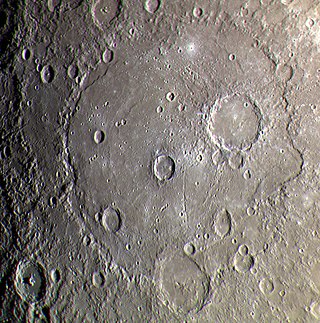
Cauchy is a small lunar impact crater on the eastern Mare Tranquillitatis. It was named after French mathematician Augustin-Louis Cauchy. It is circular and symmetric, with a small interior floor at the midpoint of the sloping inner walls. Due to the high albedo of this bowl-shaped formation, it is particularly prominent at full Moon.

Discovery Rupes is an escarpment on Mercury approximately 650 kilometers (400 mi) long and 2 kilometres (6,562 ft) high, located at latitude 56.3 S and longitude 38.3 W. It was formed by a thrust fault, thought to have occurred due to the shrinkage of the planet's core as it cooled over time. The scarp cuts through Rameau crater. It was discovered by Mariner 10.

Rupes Cauchy is a 120 km-long escarpment at 9.0°N 37.0°E on the surface of the Moon. It faces southwest, and rises about 200–300 m. It is located in the northeastern portion of the Mare Tranquillitatis, and is named after the nearby crater Cauchy.

Antoniadi Dorsum is a wrinkle ridge on Mercury at 25.1°N 30.5°W, approximately 359 km in length. In 1976, it was named by the International Astronomical Union after Eugène Michel Antoniadi.

Beethoven is a crater at latitude 20°S, longitude 124°W on Mercury. It is 630 km in diameter and was named after Ludwig van Beethoven. It is the eleventh largest named impact crater in the Solar System and the third largest on Mercury.

The Eminescu quadrangle (H-9) is one of fifteen quadrangles on Mercury. It runs from 216 to 288° longitude and from -25 to 25° latitude. Named after the Eminescu crater, it was mapped in detail for the first time after MESSENGER entered orbit around Mercury in 2011. It had not been mapped prior to that point because it was one of the six quadrangles that was not illuminated when Mariner 10 made its flybys in 1974 and 1975. These six quadrangles continued to be known by their albedo feature names, with this one known as the Solitudo Criophori quadrangle.

The Discovery quadrangle lies within the heavily cratered part of Mercury in a region roughly antipodal to the 1550-km-wide Caloris Basin. Like the rest of the heavily cratered part of the planet, the quadrangle contains a spectrum of craters and basins ranging in size from those at the limit of resolution of the best photographs to those as much as 350 km across, and ranging in degree of freshness from pristine to severely degraded. Interspersed with the craters and basins both in space and time are plains deposits that are probably of several different origins. Because of its small size and very early segregation into core and crust, Mercury has seemingly been a dead planet for a long time—possibly longer than the Moon. Its geologic history, therefore, records with considerable clarity some of the earliest and most violent events that took place in the inner Solar System.

Beagle Rupes is an escarpment on Mercury, one of the highest and longest yet seen. It was discovered in 2008 when MESSENGER made its first flyby of the planet. It has an arcuate shape and is about 600 kilometres (370 mi) long. The scarp is a surface manifestation of a thrust fault, which formed when the planet contracted as its interior cooled.

Claritas Rupes is a scarp in the Phoenicis Lacus quadrangle of Mars, located at 26° South and 105.4° West. It is 924 km long and was named after an albedo feature at 25S, 110W. The term "Rupes" is used in planetary geology to refer to an escarpments or cliff on Mars and other planets. It is the Latin word for cliff.

Leopardi is a crater on Mercury. Its name was adopted by the International Astronomical Union in 1976. Leopardi is named for the Italian writer Giacomo Leopardi, who lived from 1798 to 1837.

Enterprise Rupes is an escarpment on Mercury, located at 36.54°S, 283.46°W. It is the longest rupes on Mercury, with a length of 820 kilometers (510 mi). The escarpment was named after USS Enterprise, a ship which conducted the first surveys of the Mississippi and Amazon rivers.

Belgica Rupes is an escarpment in the Debussy quadrangle of Mercury. The escarpment is approximately 425 km long and cuts across the crater Carleton. It was named after the RV Belgica, a Belgian ship used for an expedition to determine the position of the South Magnetic Pole in 1898, and the first ship to winter in Antarctica. Its name was adopted by the International Astronomical Union (IAU) in 2013.

Vostok Rupes is an escarpment on Mercury. The scarp is a surface manifestation of a thrust fault, which formed when the planet contracted as its interior cooled.

Seuss is a crater on Mercury. Its name was adopted by the International Astronomical Union (IAU) in 2012. It is named for the American author and cartoonist Theodor Seuss Geisel, better known as Dr. Seuss.
The Rupes Toscanelli is an escarpment located on the Moon. The cliff is named after the nearby Toscanelli crater, which in turn was named after the Italian mathematician and astronomer Paolo dal Pozzo Toscanelli.
The Rupes Mercator is an escarpment located on the Moon. It is named after the neighboring Mercator crater, a name assigned to it in 1935 by the International Astronomical Union in honor of the Flemish geographer and mathematician Gérard Mercator.
The Rupes Liebig is an escarpment located on the Moon. The cliff is named after the nearby Liebig crater, which in turn was named after the German chemist Justus von Liebig (1803–1873).















